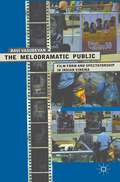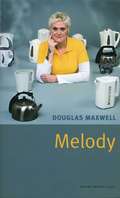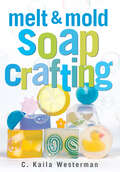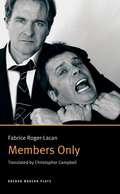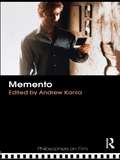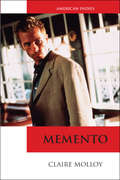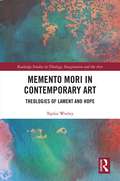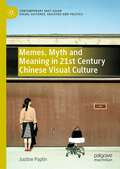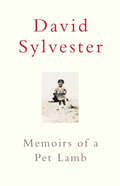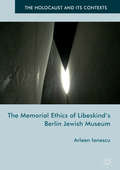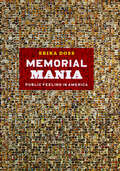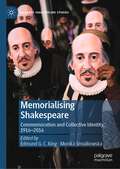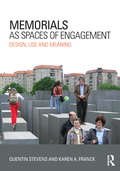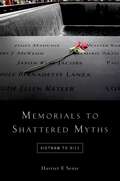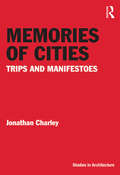- Table View
- List View
The Melodramatic Public: Film Form and Spectatorship in Indian Cinema
by R. VasudevanWhat does it mean to say Indian movies are melodramatic? How do film audiences engage with socio-political issues? What role has cinema played in the emergence of new economic forms, consumer cultures and digital technologies in a globalizing India? Ravi Vasudevan addresses these questions in a wide-ranging analysis of Indian cinema.
Melody (Oberon Modern Plays)
by Douglas Maxwell"My heart had broken. Cracked like a paving stone tapped by a mallet. All things in life which require effort - pleasure, passion, wit and thought - are impossible when your heart is cracked. And it's also very hard to get out of bed" Tonight everything must go.Melody's got secrets. Dirty, dark, sick-to-the-bottom-of-your-stomach secrets that she's hidden away from for years. The tattoos up her arms tell part of the story, but the truth is a lot more complicated. John, the boyfriend, thinks he knows Melody but he doesn't know the half of it. To him, it's just a question of presentation. Olive, Melody's irascible almost-mother-in-law, thinks she knows all about it. She isn't afraid to put her oar in, but she's got her version of events to hide. Ashley turns up at Melody's door on a mission to reveal everything. Only she doesn't know the full picture.The pressure that's been building up for years is about to boil over. Melody premiered at the Traverse Theatre in March 2006.
Melt & Mold Soap Crafting
by C. Kaila WestermanCook colorful, whimsical, eye-catching soaps right in your microwave! It&’s easy and fun with C. Kaila Westerman&’s guide to creative soap making. Westerman&’s recipes are free of harsh chemicals and she encourages you to play with colors, scents, and shapes that the whole family will enjoy — from rubber duckies to sailboats, stars, and gemstones. With an inexpensive soap base, some food coloring, and a bit of imagination, you can quickly create handy bars for kid-friendly cleaning and hours of bath time fun.
Members Only (Oberon Modern Plays)
by Chris Campbell Fabrice Roger-LacanWho was it who said that a friend is someone you can phone in the middle of the night and say, "I've just killed a man" and he'll say "OK, where's the body?"Adrien and Bernard are lifelong friends and business partners. It's Bernard's fortieth birthday. But Adrien can't come. Adrien has a big night at his club.And the crash starts there.An intimate, fast moving, cruel and tender comedy about friendship, obsession and the absurdity of desire. An epic journey from small things to the big one. "There are no rules for friendship, but there are...guidelines"Members Only opened at the Trafalgar Studios in March 2006.
Memento (Philosophers on Film)
by Andrew KaniaWithin a short space of time, the film Memento has already been hailed as a modern classic. Memorably narrated in reverse, from the perspective of Leonard Shelby, the film’s central character, it follows Leonard’s chaotic and visceral quest to discover the identity of his wife’s killer and avenge her murder, despite his inability to form new long-term memories. This is the first book to explore and address the myriad philosophical questions raised by the film, concerning personal identity, free will, memory, knowledge, and action. It also explores problems in aesthetics raised by the film through its narrative structure, ontology, and genre. Beginning with a helpful introduction that places the film in context and maps out its complex structure, specially commissioned chapters examine the following topics: memory, emotion, and self-consciousness agency, free will, and responsibility personal identity narrative and popular cinema the film genre of neo-noir Memento and multimedia Including annotated further reading at the end of each chapter, Memento is essential reading for students interested in philosophy and film studies.
Memento (Philosophers on Film)
by Andrew KaniaWithin a short space of time, the film Memento has already been hailed as a modern classic. Memorably narrated in reverse, from the perspective of Leonard Shelby, the film’s central character, it follows Leonard’s chaotic and visceral quest to discover the identity of his wife’s killer and avenge her murder, despite his inability to form new long-term memories. This is the first book to explore and address the myriad philosophical questions raised by the film, concerning personal identity, free will, memory, knowledge, and action. It also explores problems in aesthetics raised by the film through its narrative structure, ontology, and genre. Beginning with a helpful introduction that places the film in context and maps out its complex structure, specially commissioned chapters examine the following topics: memory, emotion, and self-consciousness agency, free will, and responsibility personal identity narrative and popular cinema the film genre of neo-noir Memento and multimedia Including annotated further reading at the end of each chapter, Memento is essential reading for students interested in philosophy and film studies.
Memento (American Indies)
by Claire MolloyThe book introduces Memento as an important independent film and uses it to explore relationships between "indie," arthouse and commercial mainstream cinema, independent film marketing practices and online fan communities. The book also locates Memento within debates around key film studies concepts such as genre, narrative and reception.
Memento Mori in Contemporary Art: Theologies of Lament and Hope (Routledge Studies in Theology, Imagination and the Arts)
by Taylor WorleyThis book explores how four contemporary artists—Francis Bacon, Joseph Beuys, Robert Gober, and Damien Hirst—pursue the question of death through their fraught appropriations of Christian imagery. Each artist is shown to not only pose provocative theological questions, but also to question the abilities of theological speech to adequately address current attitudes to death. When set within a broader theological context around the thought of death, Bacon’s works invite fresh readings of the New Testament’s narration of the betrayal of Christ, and Beuys’ works can be appreciated for the ways they evoke Resurrection to envision possible futures for Germany in the aftermath of war. Gober’s immaculate sculptures and installations serve to create alternative religious environments, and these places are both evocative of his Roman Catholic upbringing and virtually haunted by the ghosts of his excommunication from that past. Lastly and perhaps most problematically, Hirst has built his brand as an artist from making jokes about death. By opening fresh arenas of dialogue and meaning-making in our society and culture today, the rich humanity of these artworks promises both renewed depths of meaning regarding our exit from this world as well as how we might live well within it for the time that we have. As such, it will be a vital resource for all scholars in Theology, the Visual Arts, Material Religion and Religious Studies.
Memento Mori in Contemporary Art: Theologies of Lament and Hope (Routledge Studies in Theology, Imagination and the Arts)
by Taylor WorleyThis book explores how four contemporary artists—Francis Bacon, Joseph Beuys, Robert Gober, and Damien Hirst—pursue the question of death through their fraught appropriations of Christian imagery. Each artist is shown to not only pose provocative theological questions, but also to question the abilities of theological speech to adequately address current attitudes to death. When set within a broader theological context around the thought of death, Bacon’s works invite fresh readings of the New Testament’s narration of the betrayal of Christ, and Beuys’ works can be appreciated for the ways they evoke Resurrection to envision possible futures for Germany in the aftermath of war. Gober’s immaculate sculptures and installations serve to create alternative religious environments, and these places are both evocative of his Roman Catholic upbringing and virtually haunted by the ghosts of his excommunication from that past. Lastly and perhaps most problematically, Hirst has built his brand as an artist from making jokes about death. By opening fresh arenas of dialogue and meaning-making in our society and culture today, the rich humanity of these artworks promises both renewed depths of meaning regarding our exit from this world as well as how we might live well within it for the time that we have. As such, it will be a vital resource for all scholars in Theology, the Visual Arts, Material Religion and Religious Studies.
Memes, Myth and Meaning in 21st Century Chinese Visual Culture (Contemporary East Asian Visual Cultures, Societies and Politics)
by Justine PoplinThis book explores the impact of global change in China in what is considered in the West as ‘the Asian century’ and what this in turn means for visual culture. Unravelling a deep understanding of historical shifts in visual culture that represent socio-political mirrors of culture, it expands the Western perception of Chinese visual culture and the intertwined complexities of cultural signification. This book provides a key resource for Galleries and Academic Institutions, offering insights into understanding the systems underpinning ideas, skills and influences of the new visual culture in the Asian century.
Memoirs Of A Pet Lamb
by David SylvesterDavid Sylvester, who died in June 2001, was one of the greatest art critics of our time. He achieved fame with his work on Cezanne but became known especially for his close, perceptive studies of artists who became personal friends: Giacometti, Henry Moore, Francis Bacon. A brilliant interviewer who could make the most reticent artists disclose their secrets, he rarely revealed his own - but in the weeks before his death he wrote this brief, unforgettable account of his childhood in the 1920s. Beginning with his bewildered shuttling between an English nursery school and the turbulent Yiddish-speaking 'parental country', he reaches back for his child's-eye view. We meet Grandma Rosen with her passion for Rudolph Valentino, and Grandpa returning from his fishmonger's shop and reading out next day's runners at Kempton in his thick foreign accent. We learn of the large Sylvester clan, and of his parents' contradictory ambitions for their son: British army officer or 'a career like Noel Coward's'. We hear of friends and nannies, picnics and outings, schools and siblings; of music, politics, rows and disasters; of love and tenderness and death. Dry, comic yet poignantly unforgettable, Memoirs of a Pet Lamb brings us a life and a whole world in miniature.
The Memorial Ethics of Libeskind's Berlin Jewish Museum (The Holocaust and its Contexts)
by Arleen IonescuThis book is a detailed critical study of Libeskind’s Berlin Jewish Museum in its historical, architectural and philosophical context. Emphasizing how the Holocaust changed our perception of history, memory, witnessing and representation, it develops the notion of ‘memorial ethics’ to explore the Museum’s difference from more conventional post-World War Two commemorative sites. The main focus is on the Museum as an experience of the materiality of trauma which engages the visitor in a performative duty to remember. Arleen Ionescu builds on Levinas’s idea of ‘ethics as optics’ to show how Libeskind’s Museum becomes a testimony to the unpresentable Other. Ionescu also extends the Museum’s experiential dimension by proposing her own subjective walk through Libeskind’s space reimagined as a ‘literary museum’. Featuring reflections on texts by Beckett, Celan, Derrida, Kafka, Blanchot, Wiesel and Selma Meerbaum-Eisinger (Celan’s cousin), this virtual tour concludes with a brief account of Libeskind’s analogous ‘healing project’ for Ground Zero.
Memorial Mania: Public Feeling in America
by Erika DossIn the past few decades, thousands of new memorials to executed witches, victims of terrorism, and dead astronauts, along with those that pay tribute to civil rights, organ donors, and the end of Communism have dotted the American landscape. Equally ubiquitous, though until now less the subject of serious inquiry, are temporary memorials: spontaneous offerings of flowers and candles that materialize at sites of tragic and traumatic death. In Memorial Mania, Erika Doss argues that these memorials underscore our obsession with issues of memory and history, and the urgent desire to express—and claim—those issues in visibly public contexts. Doss shows how this desire to memorialize the past disposes itself to individual anniversaries and personal grievances, to stories of tragedy and trauma, and to the social and political agendas of diverse numbers of Americans. By offering a framework for understanding these sites, Doss engages the larger issues behind our culture of commemoration. Driven by heated struggles over identity and the politics of representation, Memorial Mania is a testament to the fevered pitch of public feelings in America today.
Memorial Mania: Public Feeling in America
by Erika DossIn the past few decades, thousands of new memorials to executed witches, victims of terrorism, and dead astronauts, along with those that pay tribute to civil rights, organ donors, and the end of Communism have dotted the American landscape. Equally ubiquitous, though until now less the subject of serious inquiry, are temporary memorials: spontaneous offerings of flowers and candles that materialize at sites of tragic and traumatic death. In Memorial Mania, Erika Doss argues that these memorials underscore our obsession with issues of memory and history, and the urgent desire to express—and claim—those issues in visibly public contexts. Doss shows how this desire to memorialize the past disposes itself to individual anniversaries and personal grievances, to stories of tragedy and trauma, and to the social and political agendas of diverse numbers of Americans. By offering a framework for understanding these sites, Doss engages the larger issues behind our culture of commemoration. Driven by heated struggles over identity and the politics of representation, Memorial Mania is a testament to the fevered pitch of public feelings in America today.
Memorial Mania: Public Feeling in America
by Erika DossIn the past few decades, thousands of new memorials to executed witches, victims of terrorism, and dead astronauts, along with those that pay tribute to civil rights, organ donors, and the end of Communism have dotted the American landscape. Equally ubiquitous, though until now less the subject of serious inquiry, are temporary memorials: spontaneous offerings of flowers and candles that materialize at sites of tragic and traumatic death. In Memorial Mania, Erika Doss argues that these memorials underscore our obsession with issues of memory and history, and the urgent desire to express—and claim—those issues in visibly public contexts. Doss shows how this desire to memorialize the past disposes itself to individual anniversaries and personal grievances, to stories of tragedy and trauma, and to the social and political agendas of diverse numbers of Americans. By offering a framework for understanding these sites, Doss engages the larger issues behind our culture of commemoration. Driven by heated struggles over identity and the politics of representation, Memorial Mania is a testament to the fevered pitch of public feelings in America today.
Memorial Mania: Public Feeling in America
by Erika DossIn the past few decades, thousands of new memorials to executed witches, victims of terrorism, and dead astronauts, along with those that pay tribute to civil rights, organ donors, and the end of Communism have dotted the American landscape. Equally ubiquitous, though until now less the subject of serious inquiry, are temporary memorials: spontaneous offerings of flowers and candles that materialize at sites of tragic and traumatic death. In Memorial Mania, Erika Doss argues that these memorials underscore our obsession with issues of memory and history, and the urgent desire to express—and claim—those issues in visibly public contexts. Doss shows how this desire to memorialize the past disposes itself to individual anniversaries and personal grievances, to stories of tragedy and trauma, and to the social and political agendas of diverse numbers of Americans. By offering a framework for understanding these sites, Doss engages the larger issues behind our culture of commemoration. Driven by heated struggles over identity and the politics of representation, Memorial Mania is a testament to the fevered pitch of public feelings in America today.
Memorial Mania: Public Feeling in America
by Erika DossIn the past few decades, thousands of new memorials to executed witches, victims of terrorism, and dead astronauts, along with those that pay tribute to civil rights, organ donors, and the end of Communism have dotted the American landscape. Equally ubiquitous, though until now less the subject of serious inquiry, are temporary memorials: spontaneous offerings of flowers and candles that materialize at sites of tragic and traumatic death. In Memorial Mania, Erika Doss argues that these memorials underscore our obsession with issues of memory and history, and the urgent desire to express—and claim—those issues in visibly public contexts. Doss shows how this desire to memorialize the past disposes itself to individual anniversaries and personal grievances, to stories of tragedy and trauma, and to the social and political agendas of diverse numbers of Americans. By offering a framework for understanding these sites, Doss engages the larger issues behind our culture of commemoration. Driven by heated struggles over identity and the politics of representation, Memorial Mania is a testament to the fevered pitch of public feelings in America today.
Memorial Mania: Public Feeling in America
by Erika DossIn the past few decades, thousands of new memorials to executed witches, victims of terrorism, and dead astronauts, along with those that pay tribute to civil rights, organ donors, and the end of Communism have dotted the American landscape. Equally ubiquitous, though until now less the subject of serious inquiry, are temporary memorials: spontaneous offerings of flowers and candles that materialize at sites of tragic and traumatic death. In Memorial Mania, Erika Doss argues that these memorials underscore our obsession with issues of memory and history, and the urgent desire to express—and claim—those issues in visibly public contexts. Doss shows how this desire to memorialize the past disposes itself to individual anniversaries and personal grievances, to stories of tragedy and trauma, and to the social and political agendas of diverse numbers of Americans. By offering a framework for understanding these sites, Doss engages the larger issues behind our culture of commemoration. Driven by heated struggles over identity and the politics of representation, Memorial Mania is a testament to the fevered pitch of public feelings in America today.
Memorialising Shakespeare: Commemoration and Collective Identity, 1916–2016 (Palgrave Shakespeare Studies)
by Edmund G. C. King Monika SmialkowskaThis book is the first comprehensive account of global Shakespeare commemoration in the period between 1916 and 2016. Combining historical analysis with insights into current practice, Memorialising Shakespeare covers Shakespeare commemoration in China, Ukraine, Egypt, and France, as well as Great Britain and the United States. Chapter authors discuss a broad range of commemorative activities—from pageants, dance, dramatic performances, and sculpture, to conferences, exhibitions, and more private acts of engagement, such as reading and diary writing. Themes covered include Shakespeare’s role in the formation of cultural memory and national and global identities, as well as Shakespeare’s relationship to decolonisation and race. A significant feature of the book is the inclusion of chapters from organisers of recent Shakespeare commemoration events, reflecting on their own practice. Together, the chapters in Memorialising Shakespeare show what has been at stake when communities, identity groups, and institutions have come together to commemorate Shakespeare.
Memorials as Spaces of Engagement: Design, Use and Meaning
by Karen A. Franck Quentin StevensMemorials are more diverse in design and subject matter than ever before. No longer limited to statues of heroes placed high on pedestals, contemporary memorials engage visitors in new, often surprising ways, contributing to the liveliness of public space. In Memorials as Spaces of Engagement Quentin Stevens and Karen A. Franck explore how changes in memorial design and use have helped forge closer, richer relationships between commemorative sites and their visitors. The authors combine first hand analysis of key examples with material drawn from existing scholarship. Examples from the US, Canada, Australia and Europe include official, formally designed memorials and informal ones, those created by the public without official sanction. Memorials as Spaces of Engagement discusses important issues for the design, management and planning of memorials and public space in general. The book is organized around three topics: how the physical design of memorial objects and spaces has evolved since the 19th century; how people experience and understand memorials through the activities of commemorating, occupying and interpreting; and the issues memorials raise for management and planning. Memorials as Spaces of Engagement will be of interest to architects, landscape architects and artists; historians of art, architecture and culture; urban sociologists and geographers; planners, policymakers and memorial sponsors; and all those concerned with the design and use of public space.
Memorials as Spaces of Engagement: Design, Use and Meaning
by Karen A. Franck Quentin StevensMemorials are more diverse in design and subject matter than ever before. No longer limited to statues of heroes placed high on pedestals, contemporary memorials engage visitors in new, often surprising ways, contributing to the liveliness of public space. In Memorials as Spaces of Engagement Quentin Stevens and Karen A. Franck explore how changes in memorial design and use have helped forge closer, richer relationships between commemorative sites and their visitors. The authors combine first hand analysis of key examples with material drawn from existing scholarship. Examples from the US, Canada, Australia and Europe include official, formally designed memorials and informal ones, those created by the public without official sanction. Memorials as Spaces of Engagement discusses important issues for the design, management and planning of memorials and public space in general. The book is organized around three topics: how the physical design of memorial objects and spaces has evolved since the 19th century; how people experience and understand memorials through the activities of commemorating, occupying and interpreting; and the issues memorials raise for management and planning. Memorials as Spaces of Engagement will be of interest to architects, landscape architects and artists; historians of art, architecture and culture; urban sociologists and geographers; planners, policymakers and memorial sponsors; and all those concerned with the design and use of public space.
Memorials to Shattered Myths: Vietnam to 9/11
by Harriet F. SenieMemorials to Shattered Myths: Vietnam to 9/11 traces the evolution and consequences of a new hybrid paradigm, which grants a heroic status to victims of national tragedies, and by extension to their families, thereby creating a class of privileged participants in the permanent memorial process. Harriet F. Senie suggests that instead the victims' families be able to determine the nature of an interim memorial, one that addresses their needs in the critical time between the murder of their loved ones and the completion of the permanent memorial. She also observes that the memorials discussed herein are inadvertently based on strategies of diversion and denial that direct our attention away from actual events, and reframe tragedy as secular or religious triumph. In doing so, they camouflage history, and seen as an aggregate, they define a nation of victims, exactly the concept they and their accompanying celebratory narratives were apparently created to obscure.
MEMORIALS TO SHATTERED MYTHS C: Vietnam to 9/11
by Harriet F. SenieMemorials to Shattered Myths: Vietnam to 9/11 traces the evolution and consequences of a new hybrid paradigm, which grants a heroic status to victims of national tragedies, and by extension to their families, thereby creating a class of privileged participants in the permanent memorial process. Harriet F. Senie suggests that instead the victims' families be able to determine the nature of an interim memorial, one that addresses their needs in the critical time between the murder of their loved ones and the completion of the permanent memorial. She also observes that the memorials discussed herein are inadvertently based on strategies of diversion and denial that direct our attention away from actual events, and reframe tragedy as secular or religious triumph. In doing so, they camouflage history, and seen as an aggregate, they define a nation of victims, exactly the concept they and their accompanying celebratory narratives were apparently created to obscure.
Memories of Cities: Trips and Manifestoes
by Jonathan CharleyMemories of Cities is a collection of essays that explore different ways of writing about the political and economic history of the built environment. Drawing upon fiction and non-fiction, and illustrated by original photographs, the essays employ a variety of narrative forms including memoirs, letters, and diary entries. They take the reader on a journey to cities such as Glasgow, Paris, Moscow, St. Petersburg, and Marseille, laying bare the contradictions of capitalist architectural and urban development, whilst simultaneously revealing alternative visions of how buildings and cities might be produced and organised.
Memories of Cities: Trips and Manifestoes
by Jonathan CharleyMemories of Cities is a collection of essays that explore different ways of writing about the political and economic history of the built environment. Drawing upon fiction and non-fiction, and illustrated by original photographs, the essays employ a variety of narrative forms including memoirs, letters, and diary entries. They take the reader on a journey to cities such as Glasgow, Paris, Moscow, St. Petersburg, and Marseille, laying bare the contradictions of capitalist architectural and urban development, whilst simultaneously revealing alternative visions of how buildings and cities might be produced and organised.
